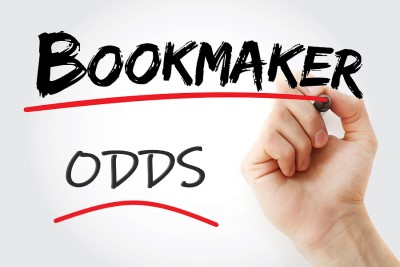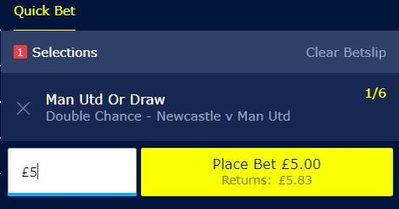 Betting on who will win a game of football is quite possibly the number one market in all of sports betting. Football is the most popular sport on the planet and a simple bet of picking which team you think will win a match is always going to appeal to the majority of people.
Betting on who will win a game of football is quite possibly the number one market in all of sports betting. Football is the most popular sport on the planet and a simple bet of picking which team you think will win a match is always going to appeal to the majority of people.
But what if you fancy a team to win but you are not quite 100% convinced and you think there is at least a decent chance they might only draw the game?
In such a situation you have a number of options but perhaps the best is the draw no bet market.
Also sometimes abbreviated to DNB, this option is perfect when you may not be sure your pick will win but you are sure they won’t lose. You may see a betting tip for a game written as, for example, “Newcastle United DNB at evens”. But what does this mean? What is draw no bet?
How Does Draw No Bet Work?

Draw no bet is easy to understand; you are picking which team you think will win a given game (in 90 minutes plus stoppage time). So in our example above, you are betting on Newcastle to win at odds of evens.
So how is this different from a bet on Newcastle to win? Well, the “DNB” element of the wager means that in the event of a draw there is no bet – in other words, if the game ends all-square, your bet is voided and you get your stake back.
If the Magpies win, you get paid out as you would normally, whilst if they draw you get your stake back and neither win nor lose anything on the bet, making it safer. If they lose, however, your bet loses.
As said, this is a great market to choose where you feel sure a draw is the worst result your selection will achieve. It essentially gives you money-back insurance on the draw, only leaving you out of pocket if your side actually lose, as opposed to just failing to win.
Are DNB Odds The Same As Match Odds?
 Bookies are not renowned for being fools and nor are they particularly well known for their generosity.
Bookies are not renowned for being fools and nor are they particularly well known for their generosity.
If you have understood our explanation of draw no bet, it should, therefore, come as no surprise to read that the DNB odds are shorter than the price you would get if backing a side to win in the main match odds market.
The reason for that is also hopefully clear: the bookmaker only wins your money if your selection loses. In contrast, if you back Newcastle to beat Sunderland in the normal Home/Draw/Away market, the bookie wins on both the Sunderland win and the draw.
The table below shows indicative odds to give you an idea of just how much you give up when you switch from the match odds to DNB.
| Standard win odds | Indicative draw no bet odds |
|---|---|
| 11/20 | 2/9 |
| 2/1 | 11/10 |
| 9/2 | 3/1 |
| 9/1 | 7/1 |
With some bookies these differences might be a little less and on very big outsiders there might only be a fraction between the prices. In such a game the DNB option may really appeal because if you back an underdog and it wins at 9/1 (DNB) instead of 10/1 (match odds), you’ll still be very happy with your winner.
If, on the other hand, your pick, the outsider, really outperforms their odds but only manage a draw, the relief of getting your stake back will be far greater. In other words, you may feel the insurance is worth it for the relatively smaller price reduction: although of course with such an outsider the chances are, unless the bookies have got it really wrong, that the favourite will win and you would lose in either scenario.
Alternatives To Draw No Bet
 With so many markets on offer on big Premier League games, and indeed most matches these days, there are alternative markets that you might want to consider.
With so many markets on offer on big Premier League games, and indeed most matches these days, there are alternative markets that you might want to consider.
One such option is the Double Chance bet. With this market you don’t just get your stake back in the event of a draw but actually win.
Whilst you can structure a double chance bet so it wins if either side wins and it only loses in the event of a draw, the more common wager is to back a side to win or draw.
Some indicative odds for either backing a team just to win, or alternatively in the win/draw double chance market are shown below.
| Standard win odds | Indicative Double Chance Odds |
|---|---|
| 11/20 | 1/7 |
| 2/1 | 8/15 |
| 9/2 | 11/8 |
| 9/1 | 11/4 |
As you can see from comparing the two tables, the double chance option pays out at smaller odds than the DNB one. This is a reflection of the fact that rather than the draw simply returning your stake it yields the same net win as if your pick actually won the game.
The other main option when you think a team might win but perhaps aren’t totally convinced, is to back them using either a handicap or an Asian handicap. People sometimes get confused between these two bets but the difference is simple: an Asian handicap only offers two selections, whereas a standard handicap gives the usual three (home win, draw and away win). In addition, the former may include fractions of goals, but the latter only ever uses whole goals.

One popular Asian option is the +0.5 goal line, where your side starts with a nominal half goal advantage. Essentially this is exactly the same bet as the draw/win double chance market, in that your bet wins with any draw or win, but goes down if your side lose the game. It is usually worth checking this Asian handicap if you do fancy the double chance as an alternative to the DNB, as the +0.5 Asian will sometimes have better odds (despite being an identical bet).
Other Asian handicap options may also be of interest, with the quarter-goal markets, for example +0.25 (which you may sometimes see written as +0, +0.5). This can be viewed as two bets, with half your stake going on a 0 handicap and half going on a half-goal handicap.
Let us say you back Man City this time with a +0.25 (or +0, +0.5) handicap at odds of 1/2 for £100. If Man City win your bet pays out in full, returning a total of £150. Equally (but opposite), if City lose, your bet also loses, so you are £100 down. The interesting part of this bet is what happens if the game ends in a draw.
The £50 that effectively went on the +0 handicap is a push. Because this was an Asian handicap with just two options, therefore no draw, that portion of the bet is returned to you, in essence being voided. The £50 that we can view as being on +0.5 is a winner and is paid at the standard odds of 1/2.
So the total return is £50 (from the push) + £75 from the £50 win at 1/2 – in other words, a total of £125. In some ways this market can be seen as a mixture of the draw no bet and the double chance, so is a great option if you can’t quite choose between those two options.
Conclusion
Draw no bet, also known as DNB, is a good option if you want a little insurance on a standard match odds bet on a team to win. If they win you’ll get lower odds than the main 90 minute game prices but the up side is that if they draw you will get your stake back and won’t lose.
As alternatives to this, the double chance market and the various Asian handicaps, and even standard handicap options, give you yet more ways to create the perfect bet.
